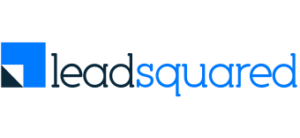Velocify, widely used in industries such as mortgage, banking, and insurance, streamlines lead management and sales cycles, enabling teams to maintain stronger control over their pipelines.
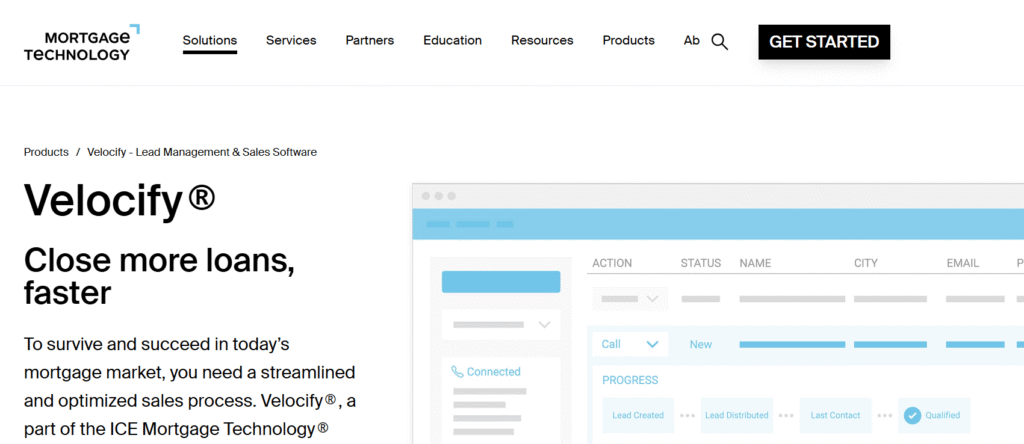
However, the sales technology landscape has evolved. Businesses no longer want one-size-fits-all CRMs—they expect platforms that integrate effortlessly with their existing tools, adapt to unique workflows, and deliver features built for their industry. That’s why more and more companies are moving toward modern Velocify alternatives. These newer solutions don’t just keep up with changing demands—they anticipate them, offering transparent pricing, powerful automation, and vertical-specific capabilities that help organizations win more deals, faster.
In this detailed guide, we’ll examine why businesses search for Velocify competitors, which characteristics are most important when assessing substitutes, and a detailed comparison of the top Velocify sales automation alternatives on the market right now; with an emphasis on US-based sales teams.
Why are teams looking for Velocify alternatives?
As sales processes grow more complex and industry needs become more specialized, many teams are finding that Velocify no longer fully meets their expectations. From the need for tighter integrations and greater customization to transparent pricing and industry-specific features, the search for a better fit has led businesses to evaluate modern CRMs built to handle today’s challenges. The following are some considerations for why sales teams are looking into alternative options:
Limited customization and scalability
Businesses’ CRM requirements get increasingly complicated as they expand. Customizing workflows, fields, and reporting dashboards to fit their unique processes is a problem that many Velocify users report. Businesses that oversee many product lines or operate in multiple industries frequently find Velocify’s customization features to be constrictive.
A user who works in Financial Services wrote on Capterra, “I can see how some users who are new to Velocify (or who are generally new to sales automation) may feel that certain functionality, such as reporting, distribution, or email capabilities may seem limited or difficult.”
Value vs. cost issues
One persistent problem has been pricing transparency. Many users complain that Velocify can get pricey as teams grow, especially compared to newer platforms providing similar or better features at lower cost.
Integration limitations
These days, sales teams use dozens of tools, including analytics software and marketing automation platforms. Even if Velocify provides integrations, businesses are increasingly in need of CRMs that work well with a wider range of apps. Operations can be slowed down by data silos and manual workarounds caused by Velocify CRM integration issues.
Challenges with user experience
Adoption rates are directly impacted by a CRM’s UI/UX. Compared to more recent platforms created with contemporary usability standards, some users believe Velocify’s UI to be less user-friendly. Regardless of how strong the backend features are, sales representatives’ productivity is negatively impacted when they have to deal with cumbersome interfaces.
A user wrote on G2, “Although they have a unique product, the bugs in the system make it a hassle to do just about anything.”
Issues with training and support
The CRM experience is made or broken by the quality of the customer service. Businesses’ experiences with Velocify’s support staff have varied: some have complained about sluggish response times or trouble obtaining assistance for complex setup problems.
Emerging competition
Innovative solutions that offer AI-driven insights, industry-specific capabilities, and more flexible deployment choices have caused the CRM and sales automation market to grow. By resolving the issues users have with outdated platforms, these Velocify rivals are gaining market share.
What to look for in a Velocify competitor
Before discussing certain options, let’s discuss the main criteria for assessing Velocify substitutes:
Routing and lead management
Your CRM should be excellent at gathering leads from various sources, allocating them sensibly according to pre-established standards (geography, product category, or representative capacity), and making sure that no opportunity is missed. Seek out:
- Lead capture from many channels (online forms, phone, email, and social media).
- Identification and handling of duplicates.
- Capabilities for lead scoring and prioritization.
Workflows and automation
Sales automation guarantees consistency and saves time. Among the key automation features are:
- Customizable workflow builders with conditional logic.
- Automated follow-up sequences and task creation.
- Email and SMS/text automation.
- Trigger-based actions that respond to lead behavior.
Integration ecosystem
Your CRM needs to play well with your existing tech stack. Evaluate:
- Native integrations with marketing automation platforms (LeadSquared, HubSpot, Marketo, Mailchimp).
- Connection to communication tools (Slack, Microsoft Teams, Zoom).
- Data warehousing and analytics platform compatibility.
- API availability for custom integrations.
Reporting and analytics
Data-driven sales decisions require robust reporting. Look for:
- Pre-built dashboards and custom report builders.
- Real-time pipeline visibility.
- Performance metrics by rep, team, and campaign.
- Forecasting capabilities.
- Revenue attribution tracking.
Pricing transparency and value
Understanding costs upfront prevents budget surprises. Consider:
- Clear pricing tiers with feature breakdowns.
- Scalable pricing that grows with your team.
- No hidden fees for essential features.
- ROI potential based on efficiency gains.
Industry-specific features
Different industries have unique needs. Whether you’re in lending, healthcare, education, or SaaS, industry-tailored CRMs offer pre-configured workflows, compliance features, and specialized reporting that generic platforms can’t match.
The best Velocify alternatives in 2025
Now let’s explore the top Velocify competitors that are winning over sales teams.
1. LeadSquared CRM
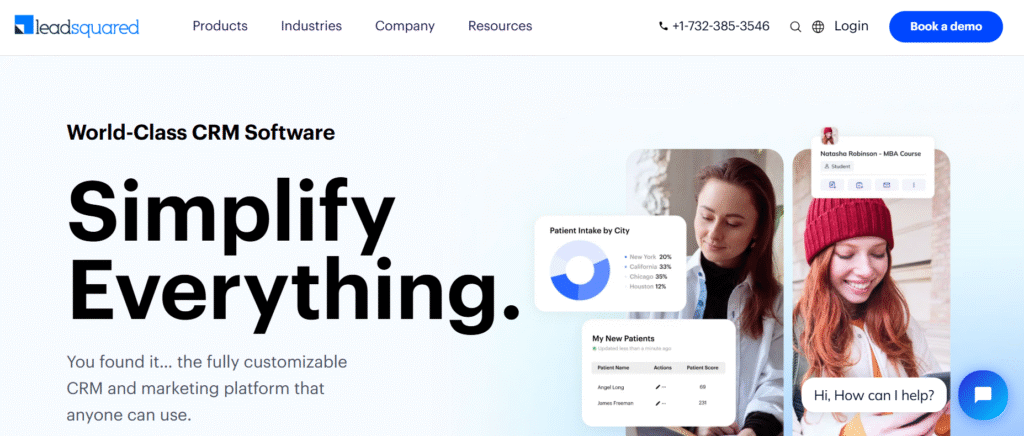
LeadSquared emerges as a standout Velocify alternative for businesses seeking powerful automation combined with industry-specific functionality. Unlike one-size-fits-all CRMs, LeadSquared offers tailored solutions for specific verticals—making it particularly compelling for companies in mortgage, insurance, healthcare, and education.
Key Strengths:
- Industry-specific CRM: Pre-built workflows, fields, and reporting for mortgage lending, insurance sales, education admissions, healthcare patient acquisition, and more.
- Advanced lead capture: Capture leads from a diverse range of sources including web forms, landing pages, phone calls, social media, and paid advertising platforms.
- Intelligent lead distribution: Round-robin, territory-based, and custom rule-based assignment ensures leads reach the right rep instantly.
- Marketing automation integration: Unlike pure CRMs, LeadSquared includes robust marketing automation—eliminating the need for separate tools!
- Mobile CRM: Full-featured mobile apps for iOS and Android keep field sales teams productive.
- US-based Support: Dedicated account managers and responsive support teams familiar with US market needs.
Ideal Use Cases:
- Mortgage lenders benefit from compliance-ready workflows and loan origination tracking.
- Educational institutions streamline admissions processes from inquiry to enrollment.
- Healthcare providers use LeadSquared to manage patient intake, appointment scheduling, and referral management.
When to choose LeadSquared: LeadSquared offers deeper customization, better integration options, and industry-specific features that Velocify lacks. For businesses in specialized verticals, this targeted approach delivers faster implementation and better ROI.
2. Salesforce Sales Cloud
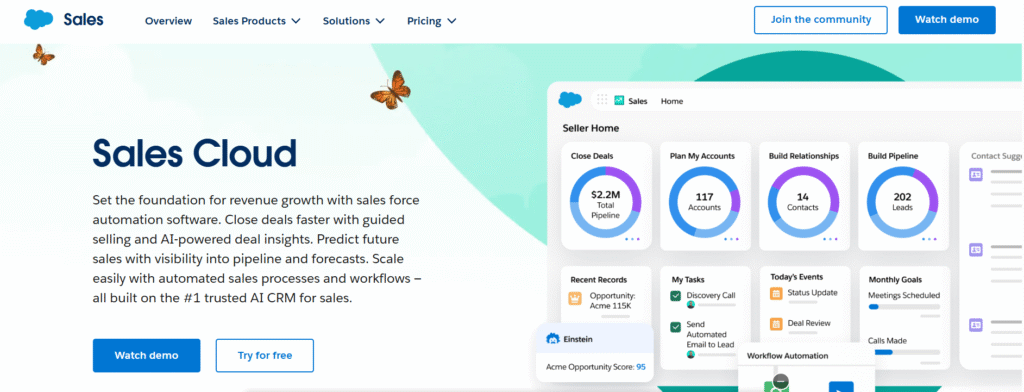
Salesforce Sales Cloud continues to dominate the CRM industry as an influential player. It offers virtually unlimited customization potential and an enormous ecosystem of third-party apps.
Key Strengths:
- Customization: Build almost any workflow, field structure, or process your business needs.
- AppExchange marketplace: Thousands of pre-built integrations and add-ons.
- AI-powered insights: Einstein AI provides predictive lead scoring, opportunity insights, and forecasting
- Comprehensive training: Trailhead learning platform offers extensive free training resources.
Considerations:
Salesforce’s power comes with complexity. Implementation typically requires dedicated administrators or consultants. Pricing can escalate quickly as you add users and features. For small to mid-sized businesses, Salesforce may be an overkill—both in capabilities and cost.
When to choose Salesforce: If you’re an enterprise with complex sales processes, multiple divisions, and budget for implementation support, Salesforce delivers unparalleled flexibility.
3. HubSpot Sales Hub
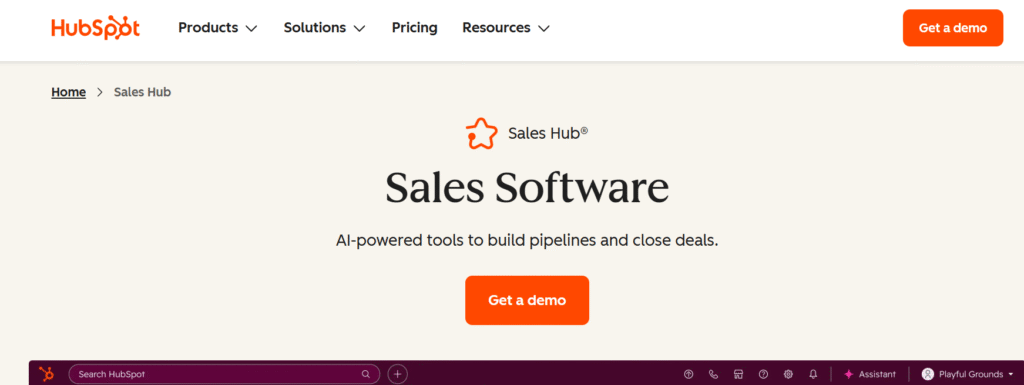
HubSpot revolutionized inbound marketing—and its Sales Hub brings that same user-friendly approach to CRM. It is for businesses that want marketing and sales tools unified in a single, intuitive platform.
Key Strengths:
- Free tier available: Start with HubSpot’s free CRM and scale up as needed.
- Intuitive interface: Minimal training required; sales reps ada
opt quickly.
- Marketing integration: Native connection to HubSpot Marketing Hub creates seamless lead handoff.
- Email tracking and templates: Built-in email tools with open/click tracking.
- Strong Community: Extensive knowledge base, community forums, and training resources.
Considerations:
While affordable at entry levels, HubSpot’s pricing increases significantly for advanced features.
When to choose HubSpot: If you’re a growing business that values ease of use and wants marketing automation bundled with your CRM, HubSpot represents an affordable replacement that won’t overwhelm your team.
4. Zoho CRM
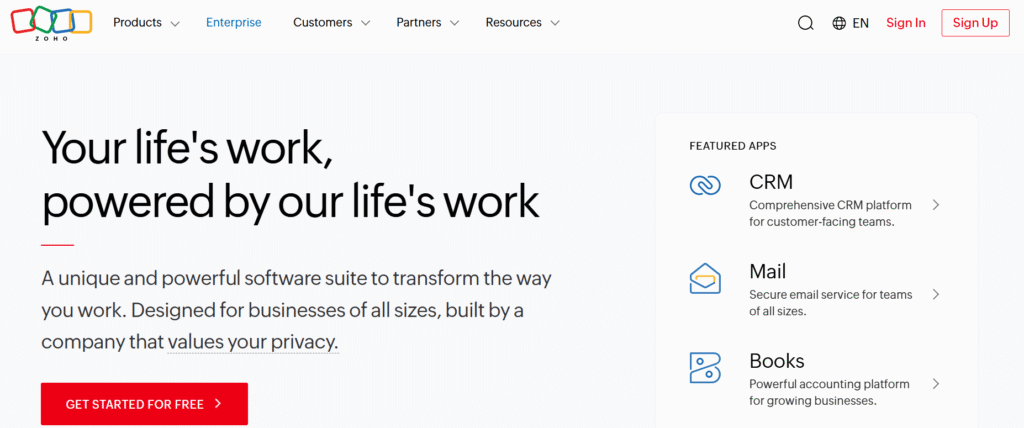
Zoho CRM delivers impressive functionality at prices that won’t break the bank. It offers a compelling value proposition without sacrificing essential features.
Key Strengths:
- Competitive pricing: Among the most affordable enterprise-grade CRMs.
- Customization options: Flexible layouts, custom modules, and workflow automation.
- Zoho Ecosystem: Integrates seamlessly with 40+ Zoho business apps.
- Multi-channel communication: Email, phone, social media, and live chat in one place.
Considerations:
The interface feels less modern compared to HubSpot or Salesforce. Some users report a steeper learning curve for advanced features. Support quality can vary.
When to choose Zoho: If budget is your primary concern and you need solid core CRM functionality, Zoho delivers great value, especially for small business needs.
5. Freshsales
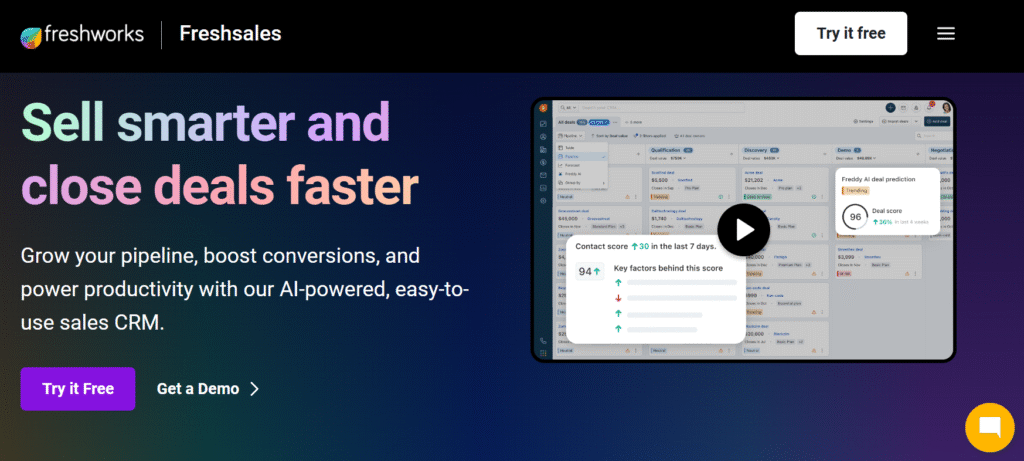
Freshsales, part of the Freshworks suite, brings AI-powered intelligence to sales teams without the complexity of enterprise platforms.
Key Strengths:
- Freddy AI: Built-in AI predicts deal outcomes, suggests next actions, and identifies at-risk opportunities.
- Visual pipeline management: Drag-and-drop deal stages with clear visibility.
- Built-in phone and email: Make calls and send emails without leaving the CRM.
- Appointment scheduling: Integrated calendar reduces booking friction.
Considerations:
While growing rapidly, Freshsales has fewer third-party integrations compared to LeadSquared, Salesforce or HubSpot. Advanced customization options are more limited than enterprise platforms.
When to choose Freshsales: If you want AI-driven insights without enterprise complexity, and value a clean, modern interface that reps actually enjoy using, Freshsales stands out.
6. Pipedrive
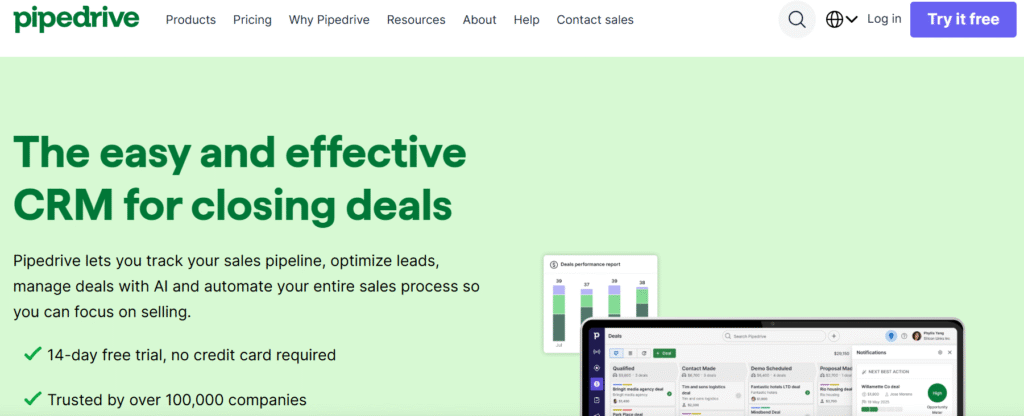
Pipedrive built its reputation on one core principle: keep salespeople focused on the pipeline. This laser focus makes Pipedrive a good choice for teams that want simplicity and pipeline visibility above all else.
Key Strengths:
- Pipeline visualization: Industry-leading visual pipeline makes deal stages crystal clear.
- Activity-based Selling: Focuses reps on next actions rather than just deal values.
- Sales assistant: AI-powered recommendations for optimal next steps
- Customizable Workflows: Automate repetitive tasks without complex setup
Considerations:
Pipedrive intentionally keeps things simple—which means it lacks some advanced features power users might want. Marketing automation is limited compared to all-in-one platforms.
When to choose Pipedrive: For small to mid-sized teams that want dead-simple pipeline management without feature bloat, Pipedrive offers one of the best user experiences.
Which Velocify alternative is right for you?
Choosing the right CRM depends on your specific business context. Here’s how to match your needs with the best option:
For small businesses (1-20 employees)
Best choices: Pipedrive, HubSpot, or Zoho CRM
Small teams need simplicity and affordability. Pipedrive offers the easiest learning curve with strong pipeline management. HubSpot provides excellent free options with room to grow. Zoho delivers robust features at budget-friendly prices.
For mid-sized companies (20-200 employees)
Best choices: LeadSquared or Freshsales
Growing businesses need scalability and automation. LeadSquared excels in financial services, healthcare, and education with its industry-specific features, while also delivering sophisticated AI capabilities that drive smarter engagement and faster conversions. Freshsales offers AI insights too, but without the same depth of vertical focus or enterprise-ready customization.
For enterprises (200+ employees)
Best choices: LeadSquared or Salesforce
Large organizations require maximum customization and scalability. Salesforce offers virtually unlimited flexibility for complex processes. LeadSquared provides enterprise-grade capabilities with better pricing and industry focus—making it ideal for Velocify replacement for enterprises in specialized sectors.
For mortgage and lending industries
Best choice: LeadSquared
The top Velocify alternative for mortgage lenders needs compliance features, loan tracking, and deep integrations with LOS systems. LeadSquared’s mortgage-specific CRM includes pre-configured workflows for loan officers, branch managers, and contact center teams—plus built-in compliance tools that Velocify users will value.
For healthcare and medical services
Best choice: LeadSquared
Patient acquisition and appointment management require HIPAA-compliant systems with healthcare-specific workflows. LeadSquared’s healthcare CRM handles patient inquiries, appointment scheduling, and follow-up nurturing—capabilities that generic CRMs struggle to deliver effectively.
For education and edtech
Best choice: LeadSquared
Admissions processes involve long nurture cycles and multi-stakeholder decisions. LeadSquared’s education CRM tracks student journeys from inquiry through enrollment, with workflows designed specifically for admissions teams and student success departments.
Making the switch: What to consider
When migrating from Velocify to an alternative, plan carefully:
- Data migration: Ensure your new platform can import all critical data—leads, contacts, deals, activities, and custom fields. Most vendors offer migration assistance.
- Integration continuity: Map out your current integrations and verify your new CRM supports them. Don’t lose connectivity to tools your team relies on daily.
- Training investment: Budget time for training. Even intuitive platforms require onboarding to maximize adoption and efficiency.
- Change management: Involve sales leadership and reps in the selection process. User buy-in dramatically impacts successful CRM transitions.
- Phased rollout: Consider piloting with a small team before company-wide deployment. This identifies issues when they’re easier to fix.
Conclusion: Finding your ideal Velocify alternative
While Velocify served sales teams well for years, the modern sales automation landscape offers more flexible and powerful options. Whether you’re seeking better customization, industry-specific features, improved user experience, or simply better value for your investment, today’s CRM market has solutions that likely fit your needs better than legacy platforms.
The right CRM transforms sales performance—but only if it matches your specific needs, industry requirements, and growth trajectory. Use this guide to evaluate your options thoughtfully, request demos from your top contenders, and make a decision that positions your sales team for success in 2025 and beyond.
Among the Velocify alternatives we’ve explored, LeadSquared stands out as the top choice. Its combination of powerful automation, industry-specific features and excellent customer support makes it particularly compelling for US-based sales teams looking to upgrade from Velocify.
See how LeadSquared’s features can accelerate your team’s sales efficiency.
FAQs on Velocify Alternatives
Is Velocify still supported?
Yes, Velocify is still operational and supported. However, the platform has undergone significant changes over the years, including ownership transitions and rebranding efforts. While Velocify continues to serve existing customers, many businesses are proactively exploring alternatives due to evolving needs, pricing concerns, and the availability of more modern platforms with advanced features. The CRM landscape has become significantly more competitive, with newer solutions offering better user experiences, more robust integrations, and industry-specific functionality that may better serve your business.
Can I migrate my data from Velocify to another CRM?
Yes, data migration from Velocify to alternative CRMs is definitely possible. Most modern CRM platforms offer data migration services or tools to help transfer your contacts, leads, deals, activities, and custom fields. The migration process typically involves:
Data export: Extracting your data from Velocify in CSV or API format.
Data mapping: Aligning Velocify fields with your new CRM’s structure.
Data cleansing: Removing duplicates and fixing formatting issues.
Import and validation: Loading data into the new system and verifying accuracy.
Testing: Ensuring all critical data transferred correctly.
Platforms like LeadSquared, Salesforce, and HubSpot offer migration assistance, with many providing dedicated migration specialists to ensure a smooth transition. Plan for 2-4 weeks for a typical migration, depending on data complexity and volume.
How does Velocify compare to Salesforce?
Velocify and Salesforce serve different market segments and offer distinct approaches to CRM.
Key differences:
Customization: Salesforce offers far more customization capabilities, while Velocify provides pre-built workflows for specific industries. Salesforce can be configured for virtually any business process, whereas Velocify excels within its defined use cases.
Complexity: Velocify is simpler to implement and use for lead management, while Salesforce requires more technical expertise and often dedicated administrators.
Cost: Salesforce typically has higher total costs when factoring in implementation, customization, and ongoing management. However, it offers more functionality across the entire customer lifecycle.
Analytics: Salesforce provides more advanced reporting and AI-driven insights through Einstein, while Velocify focuses on sales-specific metrics.
Bottom Line: Consider LeadSquared as a middle ground—offering industry-specific features like Velocify with the customization and scalability closer to Salesforce, often at a better price point.
How long does it take to implement a Velocify alternative?
Implementation timelines vary based on several factors:
Quick Implementation (2-4 weeks):
Platforms: Pipedrive, HubSpot, Freshsales
Scenario: Small teams (under 20 users) with straightforward processes
Includes: Basic setup, data migration, and essential training
Standard Implementation (4-8 weeks):
Platforms: LeadSquared, Zoho CRM
Scenario: Mid-sized teams (20-100 users) with some customization needs
Includes: Custom workflows, integration setup, comprehensive training, and phased rollout
Complex Implementation (8-16 weeks):
Platforms: Salesforce, enterprise LeadSquared deployments
Scenario: Large teams (100+ users) with complex processes and multiple integrations
Includes: Extensive customization, multiple integrations, change management, and staged deployment
Factors affecting timeline:
Volume and complexity of data migration
Number of required integrations
Degree of customization needed
Organizational readiness and change management requirements
Availability of internal resources vs. relying on vendor services.
Most modern CRM vendors offer implementation support to accelerate the process and ensure successful adoption.
Why are companies switching from Velocify?
Companies switch from Velocify for several key reasons:
Cost optimization: Many find alternatives offer similar or better functionality at more competitive prices with transparent pricing models.
Modern User experience: Newer CRMs offer more intuitive interfaces that require less training and drive better adoption.
Better integrations: Modern platforms integrate more seamlessly with current marketing, communication, and analytics tools.
Industry-specific features: Platforms like LeadSquared offer deeper functionality for specific verticals like lending, healthcare, and education.
Customization limitations: Growing businesses need more flexibility to configure workflows, fields, and processes.
Support quality: Users seek platforms with more responsive customer support and dedicated account management.
Mobile capabilities: Sales teams need robust mobile apps for field selling
Advanced analytics: Businesses want AI-driven insights and more sophisticated reporting capabilities.
The CRM market has evolved significantly, and many businesses simply outgrow what Velocify offers or find better-matched solutions for their specific industry and use case.
